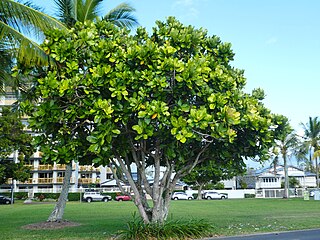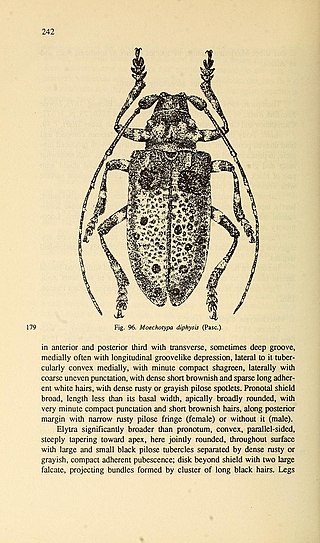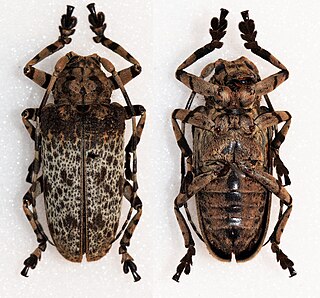
Centella asiatica, commonly known as Indian pennywort, Asiatic pennywort, spadeleaf, coinwort or gotu kola, is a herbaceous, perennial plant in the flowering plant family Apiaceae. It is native to tropical regions of Africa, Asia, Australia, and islands in the western Pacific Ocean. It is consumed as a culinary vegetable and is used in traditional medicine.

Barringtonia asiatica, also known as fish poison tree, putat or sea poison tree, is a species of Barringtonia native to mangrove habitats from islands of the Indian Ocean in the west to tropical Asia and islands of the western Pacific Ocean.
Taenia asiatica, commonly known as Asian taenia or Asian tapeworm, is a parasitic tapeworm of humans and pigs. It is one of the three species of Taenia infecting humans and causes taeniasis. Discovered only in 1980s from Taiwan and other East Asian countries as an unusual species, it is so notoriously similar to Taenia saginata, the beef tapeworm, that it was for a time regarded as a slightly different strain. But anomaly arose as the tapeworm is not of cattle origin, but of pigs. Morphological details also showed significant variations, such as presence of rostellar hooks, shorter body, and fewer body segments. The scientific name designated was then Asian T. saginata. But the taxonomic consensus turns out to be that it is a unique species. It was in 1993 that two Korean parasitologists, Keeseon S. Eom and Han Jong Rim, provided the biological bases for classifying it into a separate species. The use of mitochondrial genome sequence and molecular phylogeny in the late 2000s established the taxonomic status.

Crossotini is a tribe of longhorn beetles of the subfamily Lamiinae. It was described by Thomson in 1864.

Moechotypa is a genus of longhorn beetles of the subfamily Lamiinae.
Moechotypa ceylonica is a species of beetle in the family Cerambycidae. It was described by Stephan von Breuning in 1938. It is known from Sri Lanka.
Moechotypa dalatensis is a species of beetle in the family Cerambycidae. It was described by Stephan von Breuning in 1968. It is known from Vietnam.
Moechotypa paraformosana is a species of beetle in the family Cerambycidae. It was described by Stephan von Breuning in 1979. It is known from Taiwan.
Moechotypa penangensis is a species of beetle in the family Cerambycidae. It was described by Stephan von Breuning in 1973. It is known from Malaysia.
Moechotypa sikkimensis is a species of beetle in the family Cerambycidae. It was described by Stephan von Breuning in 1936. It is known from India.
Moechotypa adusta is a species of beetle in the family Cerambycidae. It was described by Pascoe in 1869. It is known from Cambodia, Vietnam, Laos, and Thailand.
Moechotypa coomani is a species of beetle in the family Cerambycidae. It was described by Pic in 1934. It is known from Laos, Cambodia, and Vietnam.

Moechotypa diphysis is a species of beetle in the family Cerambycidae. It was described by Pascoe in 1871. It is known from Russia, China, Japan, North Korea, and South Korea. It feeds on plants such as Ailanthus altissima, Juglans regia, Zanthoxylum simulans, and Quercus glauca.

Moechotypa formosana is a species of beetle in the family Cerambycidae. It was described by Maurice Pic in 1917. It is known from Taiwan.

Moechotypa marmorea is a species of beetle in the family Cerambycidae. It was described by Pascoe in 1864. They are known to be found on Borneo.
Moechotypa suffusa is a species of beetle in the family Cerambycidae. It was described by Pascoe in 1862. It is known from China, Cambodia, Thailand, Laos, and Vietnam.

Moechotypa thoracica is a species of beetle in the family Cerambycidae. It was described by White in 1858. It is known from India, Borneo, Laos, Sumatra, Vietnam, and Java.
Moechotypa umbrosa is a species of beetle in the family Cerambycidae. It was described by Lacordaire in 1872. It is known from Myanmar, Laos, and Thailand.
Moechotypa uniformis is a species of beetle in the family Cerambycidae. It was described by Pic in 1922. It is known from Vietnam.
Michael Postel is a French pharmacologist, Buddhist and art collector, known for his contribution of the art collections to Musée Asiatica, a Biarritz-based museum dedicated to Chinese and Indian art. He is the founder president of Franco-Indian Pharmaceuticals, a drug manufacturing company set up in 1949, which has now grown into pharmaceutical conglomerate. Postel, who reached India in 1949 on business related to his pharmaceutical company, started collecting Indian art and, over the years, gathered a collection of over 1,600 pieces. Later, he donated his entire collection to Musee Asiatica. In 2016 the Government of India awarded him the fourth highest civilian honour of the Padma Shri for his contributions to Art.







